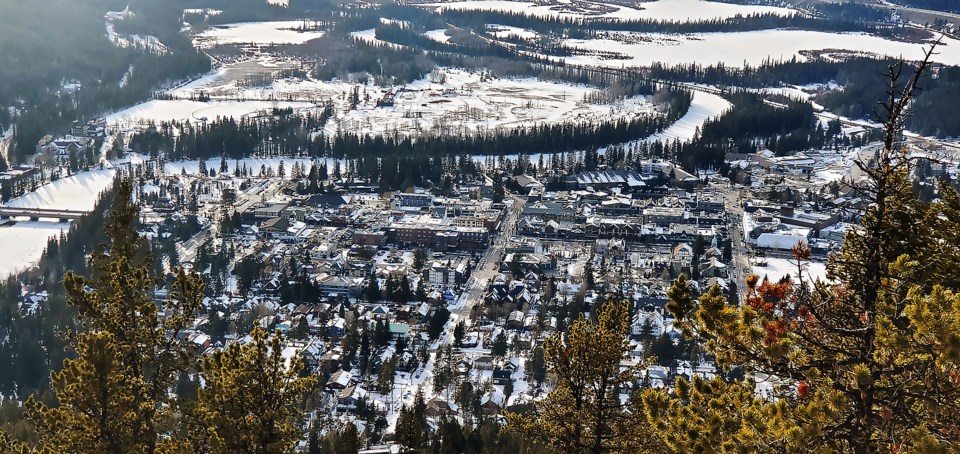BANFF – Let’s start by saying that you are the expert here.
You’ve had almost five seasons to observe the Banff Avenue pedestrian/restaurant/retail zone in operation. You know what you like about it. You know the issues that arise from it. You will decide the balance between those pros and cons, to determine your vote. The all-volunteer no team has worked hard to give you a chance to cast that vote.
We are voting no because the closure of Banff Avenue has created problems for our town and for the national park it serves.
Many of you have already voted. If you’re voting on Aug. 12, you probably know your voting intention. But just in case you’re still weighing your options, let’s review the issues you might want to consider.
BLOCKING OUR MAIN ARTERY
Banff is designed around a main artery. Banff Avenue is the central core of traffic circulation in the town, leading through the commercial area to the bridge. Blocking that artery does three things:
- It pushes all the traffic – buses, trucks, visitor vehicles – out into the residential streets. Noise levels, exhaust fumes, impatient drivers and congestion all move into formerly quiet neighbourhoods.
- It requires all that traffic to make at least four right-angled turns, in tight intersections that were never intended for heavy use or large vehicles. Pause for a moment on the sidewalk at Banff and Buffalo, or Buffalo and Beaver, or Moose and Beaver, or Muskrat and Buffalo, and watch the show.
- It raises residents’ concerns about slowing fire and ambulance response times under normal conditions and slowing emergency evacuation in the case of a short-notice, fast-moving wildfire. Town of Banff administration has stated that evacuation will not be a problem. Other experts have suggested that issues remain.
INCREASING OUR COMMERCIAL FOOTPRINT
The pedestrian/restaurant/retail zone increases the area of our town that is devoted to commercial activity, by converting public space into commercial space. Judging from the support for the yes side, it brings in more customers and more money. This is a problem in four ways:
- We have a cap on commercial development in Banff. Parks Canada has clearly expressed concern that the ped zone is getting around that cap. The cap specifically refers to built commercial space (four walls and a roof), so the Town argues that outdoor space does not matter. We all know the intent of the cap – to limit social and environmental impacts. Many Banffites feel that adding commercial space disregards that intent. Are we living up to our national park values?
- Increased commercial activity increases the need for staff, which places more pressure on our already maxed-out housing. As a community, we are trying to fix this by increasing supply. Shouldn’t we also look at demand?
- We have created another attraction in a town that’s already receiving more traffic than it can handle. Is this wise?
- This increased commercial footprint is available to some businesses, and not others. Is this fair?
LET’S RESPOND TO SOME POINTS MADE BY YES SUPPORTERS
“We’ll have traffic congestion regardless”. Yes, we will. But we have a choice about where we direct it. Does it belong in our residential neighbourhoods? Or should it remain in our commercial core?
“It’s about getting people out of their cars, and reflecting our national park values.” Walkable Banff is a goal most can agree on. But is walking and connecting with nature really what this space is about? Or is it about commercial transactions?
“We’re prioritizing people over cars.” Yes, in two blocks of Banff Avenue. Then we’re pushing those cars into places where people used to be the priority. Moving a problem around is not the same as solving it.
“It’s a place for community!” Yes, sometimes we get together with our friends at restaurants, just as we always have, and right now some of those restaurant spaces are outdoors on Banff Avenue. Do we really see many locals choosing the ped zone as a place to just go for a walk with a friend?
WHAT CAN WE ALL AGREE ON?
In online discussions, supporters from both sides have said we have more vehicles than our townsite can handle.
The suggestion is frequently made online that a no vote will freeze all further progress on our traffic issues, and stop all future exploration of ideas and alternatives. This is, of course, nonsense. Any reasonable council and administration, confronted by a solid no vote – tangible evidence of their voters’ dissatisfaction – will have incentive to pursue the bigger goal of limiting the number of day-use vehicles that enter the townsite. We need to get that number down to something our little town can handle. We need to intercept the remainder before they reach Banff National Park.
The technology exists. What’s needed is Parks Canada and the Town, at the same table, in a spirit of cooperation, working on the central problem we can all agree on. Please vote no to create space, and incentive, for that better discussion.
Leslie Taylor was Banff’s first mayor and served for two terms, and as a Banff town councillor for two terms.




